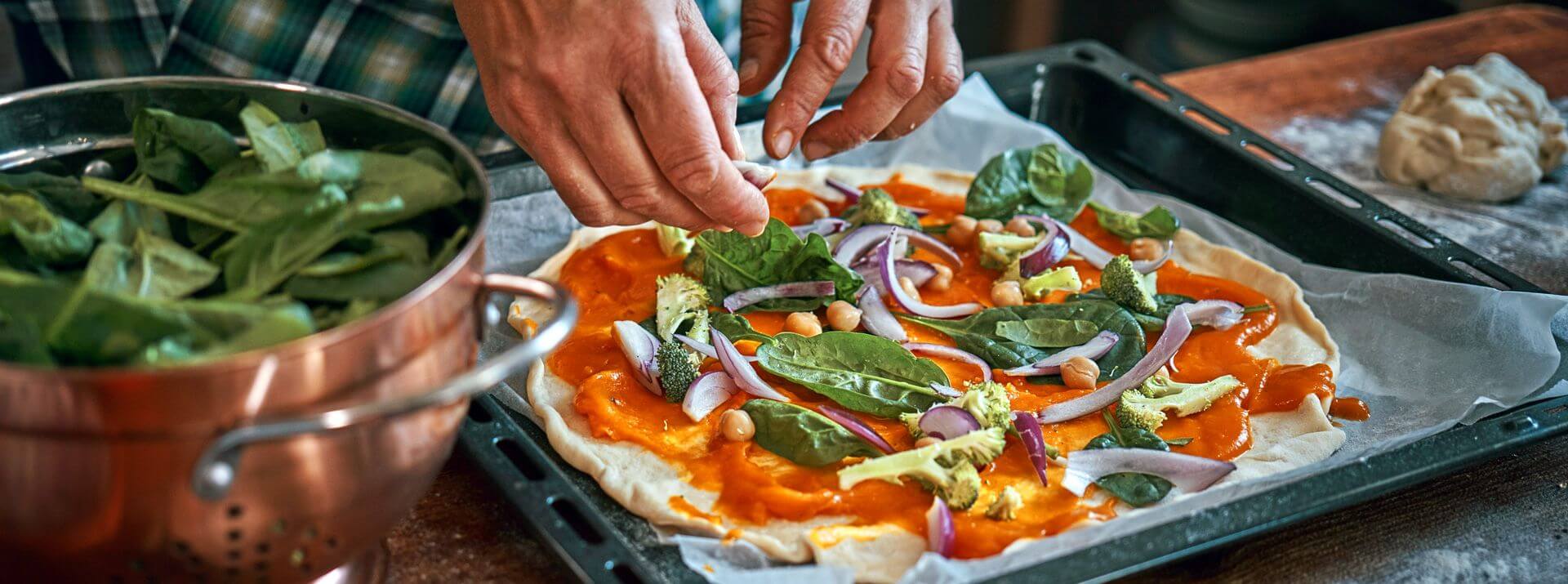Nothing gets the family in the kitchen quicker than preparing homemade pizza with a crispy crust, savory sauce, melty cheese and tasty toppings. While cooking homemade pizza is always a delicious adventure, it takes some practice to master. Use our DIY pizza pointers to create the mouthwatering pizza of your dreams.
All About That Base
The crispy crust is an essential piece of the pie. Choose from homemade or store-bought dough, or premade or frozen crusts.
Home Sweet Homemade
Homemade dough is simple to make, requiring just five ingredients: flour, water, salt, yeast and time.
- Flour: All-purpose and bread flour are the most common choices. Bread flour has more protein, resulting in a chewier crust.
- Water: Use water that’s warm enough to activate the yeast but not too warm that it will kill it.
- Salt: Be generous with salt as it not only flavors the dough but also tightens the gluten, strengthening the structure.
- Yeast: Instant dry yeast works best. You can also enhance the dough’s flavor and texture by using beer in place of yeast. The alcohol cooks off, so beer crusts are family-friendly!
- Time: Time is the honorary fifth ingredient of homemade dough, as letting it rest allows the elasticity, texture and flavor to develop. Rest the dough in a warm area for 60 to 90 minutes or in the refrigerator for one to three days.
Ready-to-Go Prepared Dough: Don’t have time to make your own pizza dough? Pick up Roche Bros. pizza dough. With all the qualities of a from-scratch dough, it’s an easy timesaver!
Pro Dough Tip: Whether working with scratch-made or store-bought, prevent torn or overworked dough by bringing it to room temperature before rolling it out.
To bake directly on the racks or not to?
That is the question, and the answer depends on the type of crust you’re working with. Raw pizza dough shouldn’t go directly on the oven rack because the weight of the toppings causes the dough to fall through. Instead, use a preheated baking pan or pizza stone that’s sprinkled with cornmeal before baking to prevent sticking. If you’re baking a shelf-stable or frozen pizza crust, you can cook it directly on the oven rack.
Blast the Heat
Scorching-hot pizzeria ovens create crusts with char-kissed exteriors and soft, cloud-like interiors. One way to achieve this at home is to get your oven to around 500°. It’s also crucial to preheat your baking pan or pizza stone for 30 minutes to ensure proper browning and crisping.
Thrill of the Grill
While a super-hot oven cooks pizza best, medium-low heat is the sweet spot for grilling pizzas. And believe it or not, pizza cooked directly on the grates won’t fall through. But how do you get your delicate dough from your kitchen to the grill? The underside of a rimmed baking pan allows you to effortlessly slide your topped pizza onto the grill with no extra maneuvering. Sprinkle the bottom of the pan with cornmeal before placing the pizza on top to help prevent sticking.
Sauce it Up
Sauces are a fundamental building block to great-tasting pies, and there are plenty of options to switch up the flavor. Go classic with red sauce, or try pesto, olive oil and garlic, sweet potato purée, Alfredo, creamed spinach or barbeque sauce. And don’t forget sauces like hot honey, garlic sauce or balsamic glaze for drizzling over the toppings.
Cheese, Please!
With unmatched meltability, mozzarella is the long-standing favorite cheese for pizzas, but there are other complex, rich cheeses that add a depth of flavor. Try Cheddar, Parmesan, chèvre, provolone, fontina, smoked Gouda or Gorgonzola or a blend of your favorites!
Less is More
While it’s easy to go wild with toppings on homemade pizzas, less is more for ensuring a crisp, well-cooked pizza. Whether you prefer classic combinations or want to take your taste buds on a gastronomic adventure, choose two to three complementary flavors for homemade pizzas. Start with our pizza recipes featuring taco-style steak, oysters Rockefeller, and sweet potatoes, black beans, kale and goat cheese!
